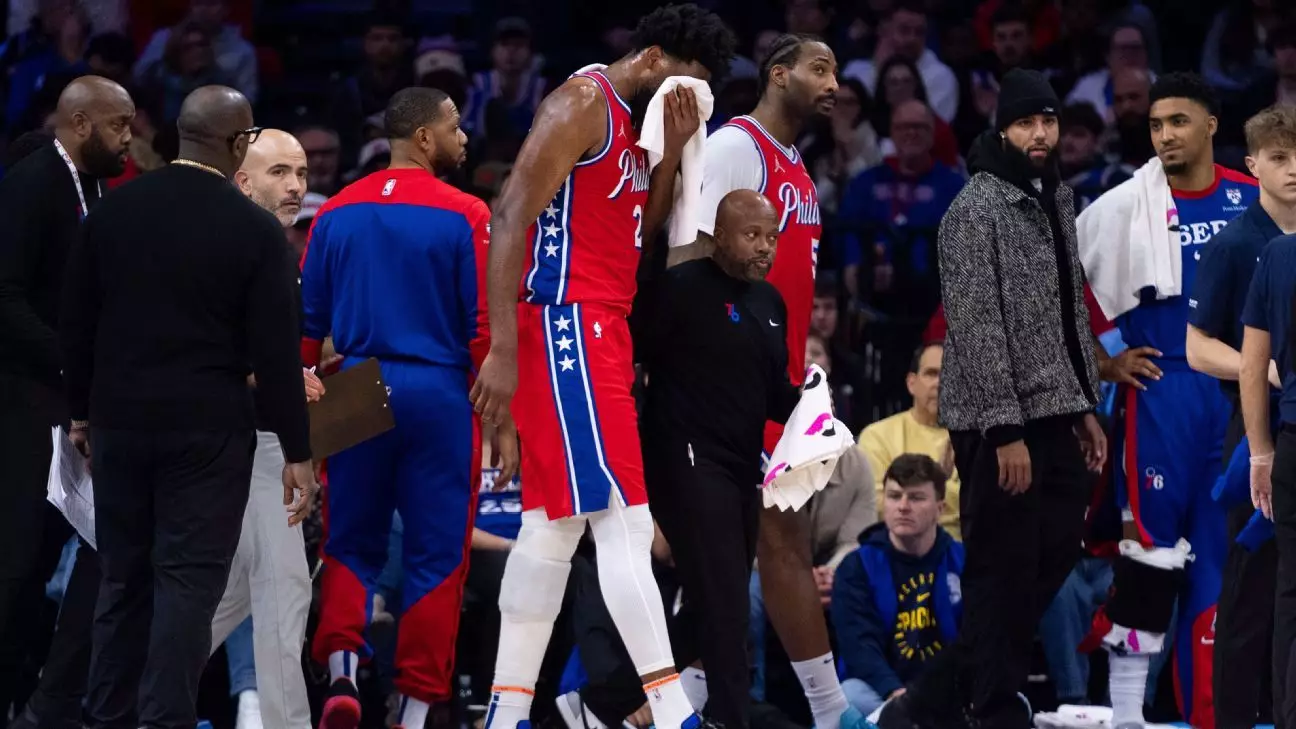In a disappointing turn of events for the Philadelphia 76ers, star player Joel Embiid has sustained a sinus fracture during a recent game against the Indiana Pacers. This incident occurred during a pivotal moment in the match, capturing the attention—and concern—of fans and analysts alike. The injury took place as Embiid engaged with Indiana’s Bennedict Mathurin for a defensive rebound. In an unfortunate twist, he was struck in the face by Mathurin’s forearm and elbow, resulting in an immediate collapse onto the court.
Such occurrences are painfully familiar for Embiid, a player whose career has been shadowed by injuries. Almost embarrassingly, he remained sprawled on the court as the game proceeded, clutching his face, which left spectators concerned. The severity of the injury led the team to quickly rule him out for the remainder of the game, citing “impact to the right side of the face,” emphasizing the potential risks associated with such physical confrontations in sports.
Upon the game’s conclusion, Coach Nick Nurse provided a brief update, indicating that Embiid was undergoing further testing—missed opportunities for clarity in an already tumultuous season. Subsequently, the team confirmed the diagnosis of a sinus fracture, and he is slated for reevaluation over the weekend. Such vague communication leaves fans and teammates with uncertainty about his future within the season’s grueling schedule.
Before his injury, Embiid had been contributing modestly with 12 points, four rebounds, and five assists in just 17.5 minutes of play. However, his performance has been a mere sliver of what fans expect from a two-time All-Star. This season, he has only appeared in six of the team’s 23 games and has been continuously hampered by various physical setbacks, notably persistent swelling in his left knee and a three-game suspension stemming from a controversial incident with a member of the media.
The assembly of Philadelphia’s much-lauded “Big Three”—Embiid, Tyrese Maxey, and newly added Paul George—has yet to see its full potential. These three players have only shared the court for a handful of games, leaving fans to ponder the implications of their limited chemistry as the Sixers struggle, currently holding a disappointing record of 7-16. Maxey, stepping up in Embiid’s absence, reflected on the team’s need for resilience: “You just have to move on and practice when we practice again and have a next man up mentality.” This statement resonates with the challenges teams face in the face of adversity, yet it also underscores the reality that such a mindset can only get a team so far.
Embiid’s injuries transcend mere physical constraints; they manifest emotional weight on the player as well. Last season, he faced not just physical injuries but also shared that he experienced Bell’s palsy during the playoffs, revealing the psychological burden accompanying athletic performance. In a candid moment after a game last week, he described the struggle with his left knee as “depressing”—an insight into the deeply personal challenges that athletes often conceal from the public eye.
Coach Nurse was optimistic about Embiid’s mental state before the latest injury, highlighting that he had been performing well in practice. Yet, the recurring nature of injuries fosters an environment of frustration and feelings of defeat. As Nurse poignantly noted, “I can imagine that he feels like the black cloud is over him a little bit.” This metaphor captures the somber tone surrounding Embiid’s season: one that continually threatens not just his professional aspirations but his overall mental well-being.
Joel Embiid’s ongoing injuries are not merely plot points in a season to be forgotten; they highlight the fragility of athleticism. As fans remain hopeful for his recovery, the 76ers must recalibrate their strategies and maintain their morale in the uncertain path ahead. The journey forward demands resilience, adaptability, and perhaps a reimagining of success for this beleaguered franchise.

